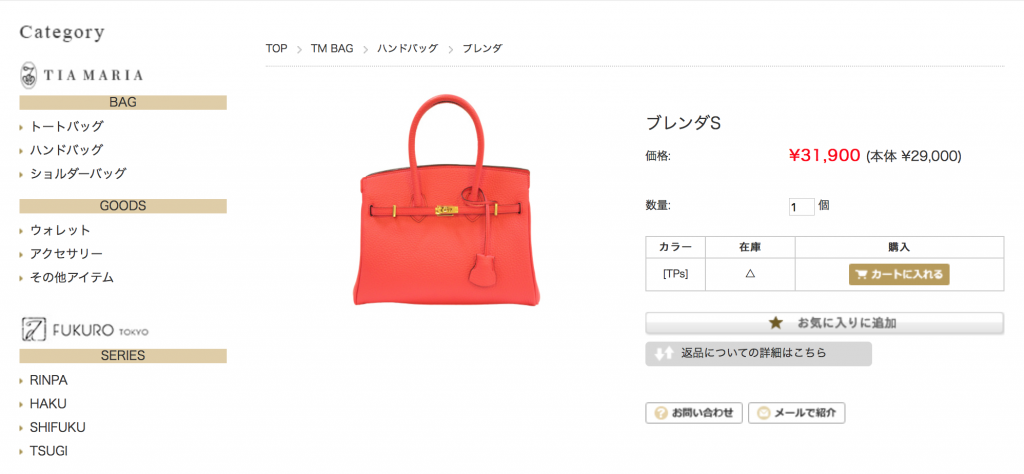Hermès has prevailed in a trademark fight over the 3D shape of its iconic Birkin bag in Japan. Following a win in June when the Tokyo District Court determined that Kabushiki Kaisha Tia Maria (“Tia Maria”) had engaged in trademark infringement and passing off, the defendant handbag-seller appealed to the Japan IP High Court, arguing that, among other things, there are visual dissimilarities between the two parties’ bags, as well as marked differences in the prices and the quality of their offerings. Unpersuaded by Tia Maria’s arguments, the High Court sided with Hermès and ordered the defendant to pay JPY2,900,000 ($27,973) in damages.
In its appeal to the Japan IP High Court, as first reported by Osaka-based firm Marks IP, Tia Maria argued that the Tokyo District Court had erred in its determination of the case, asserting that the shape of its handbags differ from the registered 3D shape of Hermès’ Birkin bag, as do the prices at which they are offered. (The prices of Hermès’ Birkin bags start at nearly $10,000 dollars, Tia Maria asserted, whereas its own bags retail for between $192 and $289). The result of such distinctions, according to Tia Maria? A lack of potential confusion among consumers as to source/nature of the two parties’ products, the key inquiry in a trademark infringement matter.
Beyond that, Hermès’ “products are made of high-grade leather and are sewn [in a] high quality [manner], while [Tia Maria’s] products are made of synthetic leather,” Tia Maria argued, asserting that “the difference [between the two companies’ bags] can be easily recognized,” thereby, further leading to little risk of consumer confusion. And still yet, the risk of confusion is low, per Tia Maria, due to the fact that Hermès’ “products are sold under the name Birkin, and the [Hermès’] logo and the serial number of the craftsman are attached, [while Tia Maria’s] products [bear its own] trade name, Tia Maria.”
Because the products “are different in terms of price, quality, product name, logo, etc., there is no risk of misunderstanding” among consumers as to the source of the goods and/or Hermès’ affiliation with or endorsement of the lookalike Tia Maria bags, the company told the court by way of its appeal.
In its December 17 decision, the Japan IP High Court upheld the favorable ruling for Hermès, holding that its trademark for the 3D design of the Birkin bag, which has been registered in Japan since September 9, 2011, was infringed by Tia Maria’s lookalike bags.
Looking first to Hermès’ 3D Birkin bag trademark, the court held that the design is a valid mark – that serves to indicate the source of the product and distinguish it from those of other brands – in Japan (despite Tia Maria’s argument to the contrary), and in fact, is a “well known” mark as a result of Hermès’ “sales and advertising activities” of the bag in the Japanese market, and more broadly, its sale of the specific handbag style since 1984.

With that in mind, the court found that Tia Maria’s handbags consist of “almost the same three-dimensional shape as the [Hermès] trademark,” and make use of the protectable combination of features that make up Hermès’ trademark, including, the “distinctive three-lobed flap design with keyhole-shaped notches to fit around the base of the handle, a dimpled triangular profile, closure [that] consists of two thin, horizontal straps designed to fit over the flap, with metal plates at their end that fit over a circular turn lock, padlock [that] fits through the center eye of the turn lock and typically, a key fob affixed to a leather strap, one end of which is affixed to the bag by wrapping around the base of one end of the handle.”
Addressing Tia Maria’s arguments about the differing “price, quality, product name, logo, etc.” of the two companies’ bags, the court stated that “it cannot be said that [such differences] do not immediately lead to misunderstanding and confusion between the shape of [Tia Maria’s] goods and [Hermès’] trademark in light of the actual circumstances of trade.” The court noted that the question of whether Tia Maria’s products are likely to cause “misunderstanding and confusion” requires a consideration of “the actual conditions of trade” for the parties’ products, and that includes – quite interestingly – the existence of the thriving resale market for Hermès’ Birkin bags.
While it is true that the “sales channels [for new Hermès bags] are relatively limited,” and consist exclusively of sales through “directly-managed stores and specialty [Hermès] stores,” the court determined, it is significant that “a second-hand market has been established for used [Hermès] products … and they are actively traded in [non-Hermès] stores and on the Internet.” As a result of such sales of pre-owned Hermès bags outside of the company’s own chain of distribution, “There is a commonality in the market for both new and used products between [Tia Maria’s] products and [Hermès’] products,” the court said.
Additionally, “The quality of used products, even [Hermès’] products, is degraded compared to new products, and the price is lower than new products,” according to the court. (It is worth noting that this is often not the case with certain styles of Hermès, including Birkin bags, which routinely and rather notoriously hold their retail to resale value better than nearly all other types of handbags, and in many cases, resell for the same or a higher value than at the initial point of sale. This fact has prompted at least some analysts to suggest that Birkin and other iconic Hermès styles may make for “better” investments that the S&P 500 and/or gold).
Speaking further about the significance of the existence of the robust resale market, the court held that in resale scenarios, “The origin and product name may not be as clear as [they are] for new products, and the transactions are conducted without sufficiently confirming the quality, product name, existence of logos, etc.” As a result, “It is difficult to say that [Tia Maria’s] products and [Hermès’] products, etc. are clearly distinguished by price, product quality, product name, and logo, because there are many cases (especially in the case of transactions on the Internet) where transactions are conducted without sufficiently checking the quality, product name, and existence of logos, etc.”
“Given that used products of [Hermès] are actively traded in the market, the possibility of confusion between [its] products and [Tia Maria’s] products, etc. is recognized to exist concretely,” the court stated, which ultimately found that “in light of the actual conditions of trade, the shape of [Tia Maria’s] goods, etc. is likely to cause misunderstanding and confusion with [Hermès’] trademark and is recognized as similar.”
With the foregoing in mind, the court held that on the basis on the “at least 100 bags” that Tia Maria sold between August 11, 2010 and February 14, 2018, the defendant is on the hook for $27,973 in damages, a sum that includes “reasonable attorney’s fees.”











